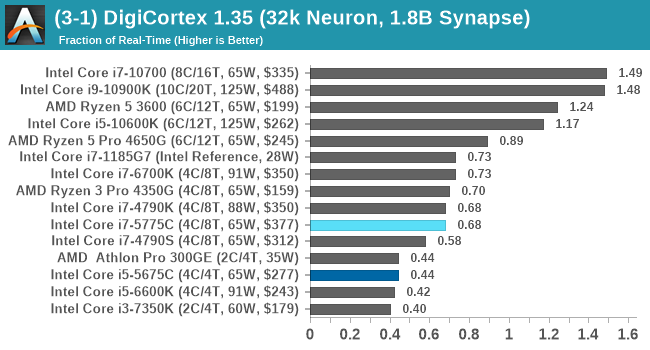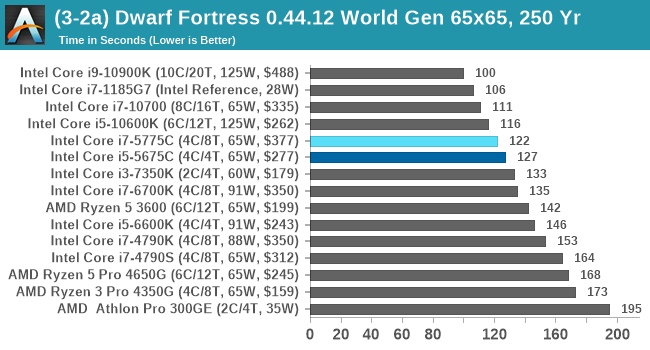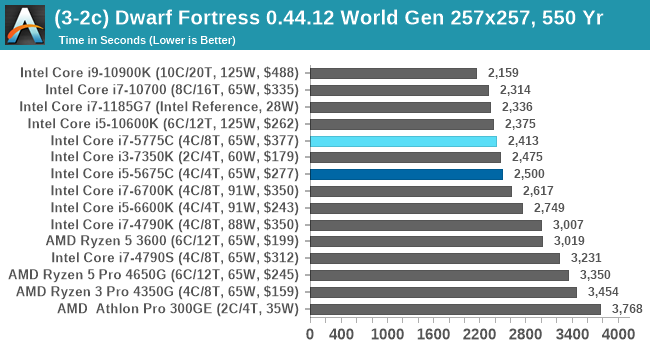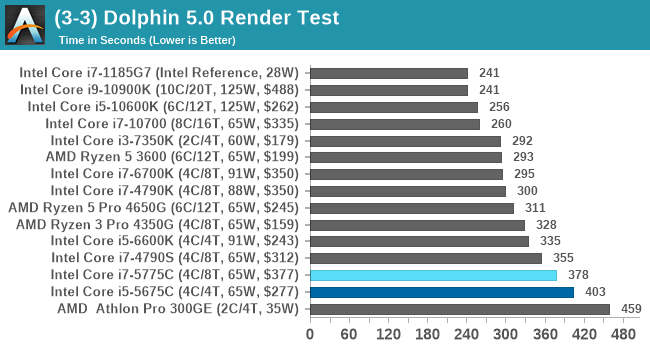A Broadwell Retrospective Review in 2020: Is eDRAM Still Worth It?
by Dr. Ian Cutress on November 2, 2020 11:00 AM ESTCPU Tests: Simulation
Simulation and Science have a lot of overlap in the benchmarking world, however for this distinction we’re separating into two segments mostly based on the utility of the resulting data. The benchmarks that fall under Science have a distinct use for the data they output – in our Simulation section, these act more like synthetics but at some level are still trying to simulate a given environment.
DigiCortex v1.35: link
DigiCortex is a pet project for the visualization of neuron and synapse activity in the brain. The software comes with a variety of benchmark modes, and we take the small benchmark which runs a 32k neuron/1.8B synapse simulation, similar to a small slug.
The results on the output are given as a fraction of whether the system can simulate in real-time, so anything above a value of one is suitable for real-time work. The benchmark offers a 'no firing synapse' mode, which in essence detects DRAM and bus speed, however we take the firing mode which adds CPU work with every firing.
The software originally shipped with a benchmark that recorded the first few cycles and output a result. So while fast multi-threaded processors this made the benchmark last less than a few seconds, slow dual-core processors could be running for almost an hour. There is also the issue of DigiCortex starting with a base neuron/synapse map in ‘off mode’, giving a high result in the first few cycles as none of the nodes are currently active. We found that the performance settles down into a steady state after a while (when the model is actively in use), so we asked the author to allow for a ‘warm-up’ phase and for the benchmark to be the average over a second sample time.
For our test, we give the benchmark 20000 cycles to warm up and then take the data over the next 10000 cycles seconds for the test – on a modern processor this takes 30 seconds and 150 seconds respectively. This is then repeated a minimum of 10 times, with the first three results rejected. Results are shown as a multiple of real-time calculation.

DigiCortex seems to fall into layers of performance, and the Core i7-5775C, with DDR3-1600, comes very close to the Core i7-6700K with DDR4-2133.
Dwarf Fortress 0.44.12: Link
Another long standing request for our benchmark suite has been Dwarf Fortress, a popular management/roguelike indie video game, first launched in 2006 and still being regularly updated today, aiming for a Steam launch sometime in the future.
Emulating the ASCII interfaces of old, this title is a rather complex beast, which can generate environments subject to millennia of rule, famous faces, peasants, and key historical figures and events. The further you get into the game, depending on the size of the world, the slower it becomes as it has to simulate more famous people, more world events, and the natural way that humanoid creatures take over an environment. Like some kind of virus.
For our test we’re using DFMark. DFMark is a benchmark built by vorsgren on the Bay12Forums that gives two different modes built on DFHack: world generation and embark. These tests can be configured, but range anywhere from 3 minutes to several hours. After analyzing the test, we ended up going for three different world generation sizes:
- Small, a 65x65 world with 250 years, 10 civilizations and 4 megabeasts
- Medium, a 127x127 world with 550 years, 10 civilizations and 4 megabeasts
- Large, a 257x257 world with 550 years, 40 civilizations and 10 megabeasts
DFMark outputs the time to run any given test, so this is what we use for the output. We loop the small test for as many times possible in 10 minutes, the medium test for as many times in 30 minutes, and the large test for as many times in an hour.



Here's where we start to see some of the benefits of the lower latency eDRAM out to 128 MB. That larger cache pushes both Broadwell parts very near to modern CPUs, putting all the older models down the list. This is something AMD's APUs aren't particularly good at, due to the very limited L3 cache in play.
Dolphin v5.0 Emulation: Link
Many emulators are often bound by single thread CPU performance, and general reports tended to suggest that Haswell provided a significant boost to emulator performance. This benchmark runs a Wii program that ray traces a complex 3D scene inside the Dolphin Wii emulator. Performance on this benchmark is a good proxy of the speed of Dolphin CPU emulation, which is an intensive single core task using most aspects of a CPU. Results are given in seconds, where the Wii itself scores 1051 seconds.

Unfortunately Dolphin isn't a fan of the eDRAM versions.












120 Comments
View All Comments
Billy Tallis - Wednesday, November 4, 2020 - link
Ian already said he tests at JEDEC speeds, which includes the latency timings. Using modules that are capable of faster timings does not prevent running them at standard timings.Quantumz0d - Tuesday, November 3, 2020 - link
Don't even bother Ian with these people.Nictron - Wednesday, November 4, 2020 - link
I appreciate the review and context over a period of time. Having a baseline comparison is important and it is up to us the reader to determine the optimal environment we would like to invest in. As soon as we do the price starts to skyrocket and comparisons are difficult.Reviews like this also show that a well thought out ecosystem can deliver great value. Companies are here to make money and I appreciate reviewers that provide baseline compatible testing over time for us to make informed decisions.
Thank you and kind regards,
GeoffreyA - Tuesday, November 3, 2020 - link
Thanks, Ian. I thoroughly enjoyed the article and the historical perspective especially. And the technical detail: no other site can come close.eastcoast_pete - Tuesday, November 3, 2020 - link
Ian, could you comment on the current state of the art of EDRAM? How fast can it be, how low can the latency go? Depending on those parameters and difficulty of manufacturing, there might be a number of uses that make sense.One where it could is to possibly allow Xe graphics to use cheaper and lower power LPDDR-4 or -5 RAM without taking a large performance hit vs. GDDR6. 128 or 256 MB EDRAM cache might just do that, and still keep costs lower. Pure speculation, of course.
DARK_BG - Tuesday, November 3, 2020 - link
Hi , what I'm wondering is where the 30% gap between the 5770C and 4790K in Games came from , compared to your original review and all other reviews out there of 5770C. Since I'm with a Z97 platform and 4.0GHz Xeon , moving to 4770k or 4790K doesn't make any sense given their second hand prices but 5770C on this review makes alot of sense.So is it the OS,the drivers , some BIOS settings or on the older reviews the systems were just GPU limited failing to explore the CPU performance?
jpnex - Friday, January 8, 2021 - link
Lol, no, the I7 5775c is just stronger than an i7 4790k, this is a known fact. Other benchmarks show the same thing. Old benchmarks don't show It because back then people didn't know that deactivating the iGPU would give a performance boost.DARK_BG - Wednesday, July 20, 2022 - link
I forgot back then to reply back , based on this review I've sourced 5775C (for a little less than 100$ this days going for 140-150$) coupled with Asus Z97 Pro and after some tweaking (CPU at 4.1GHz , eDRAM at 2000MHz and some other minor stuff that I already forgot) the difference compared to the Xeon 4.0GHz in games was mind blowing.Later I was able to source and 32GB Corsair Dominator DDR3 2400MHz CL10 just for fun to make it top spec config. :)It is a very capable machine but this days I'll swap it for Ryzen 5800X3D to get the final train on the fastest Windows 7 capable gaming system.Yeah i know it is OLD OS but everything I need runs flawessly for more than a decade with only reainstall 7 years ago due to an SSD failure. It is my only personal Intel System for the past 22 years since it was the for a first time the best price performance second hand platform for a moment , all the rest were AMD based and I keep them all in working condition.
BTW I was able to run Windows XP 64bit on the Z97 platform , I just need to swap the GTX 1070 for GTX 980/980 Ti to be fully functional everything else runs like a charm under XP i was able to hack the driver to install as an GTX 960 so I have a 2D hardware acceleration under XP on GTX 1070 since nvidia havent changed anything in regard to 2D compared to the previous generation
dew111 - Tuesday, November 3, 2020 - link
Rocket lake should have been the comet lake processor with eDRAM. Instead they'll be lucky to beat comet lake at all.erotomania - Tuesday, November 3, 2020 - link
Thanks, Ian. I enjoyed this article from a NUC8i7BEH that has 128MB of coffee-flavored eDRAM. Also, thanks Ganesh for the recent reminder that Bean > Frost.